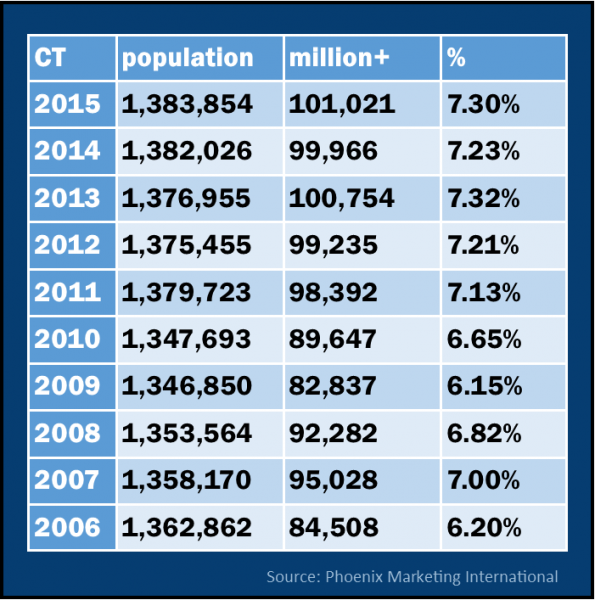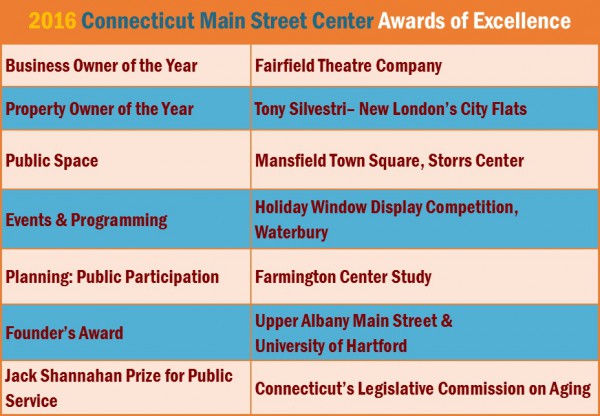Fast Forward Past Fiscal Crisis: CT Developing Goals for the Year 2041
/New goals approved in the waning hours of the state legislative session focus not on the impending deficit in the next two years, but what Connecticut should look like a quarter-century from now. Fast forwarding to the future, the newly approved legislation establishes a “Connecticut 500 Project” to develop a plan to, within 25 years:
- Increase private sector jobs by 500,000;
- Increase Connecticut’s population by 500,000;
- Increase by 500 the number of start-up companies organized around Connecticut-developed intellectual property;
- Increase by 500 the number of students graduating from each state college and university;
- Achieve a national ranking within the top five for economic growth, public education, quality of life, and private sector employee salary;
- Maintain Connecticut’s position within the top five for productivity, higher education, and income per capita.
 “This is an effort to reassert Connecticut as one of the strongest economies in the nation and in the world,” State Representative William Tong recently told WNPR. He's co-chair of the state’s Commission on Economic Competitiveness, and said the Connecticut 500 Project comes directly out of the work of the commission. The commission will continue to flesh out the Connecticut 500 Project, and look to hire a private consultant to take the plan forward, WNPR reported.
“This is an effort to reassert Connecticut as one of the strongest economies in the nation and in the world,” State Representative William Tong recently told WNPR. He's co-chair of the state’s Commission on Economic Competitiveness, and said the Connecticut 500 Project comes directly out of the work of the commission. The commission will continue to flesh out the Connecticut 500 Project, and look to hire a private consultant to take the plan forward, WNPR reported.
Tong added that the project is modeled after similar efforts in states like New York, Minnesota, and Ohio, and one of its centerpieces will likely be to move away from Connecticut’s traditional suburban strategy, focusing instead on building population and business vitality in its urban cores.
Some of the groundwork begins sooner, and comes with a price tag.
The state Department of Economic and Community Development (DECD) is required to establish a Talent Advisory Committee to assess shortages in the software development and other technology workforces, and develop pilot programs to correct such shortages. And the Committee would develop knowledge enterprise zones around colleges and universities with the same benefits accorded entities in enterprise zones.
Details are still to be worked out as to how such an initiative would unfold, and the precise role of the state’s public and private institutions. The committee would design a pilot program to recruit developers and train state residents over the next 10 years, according to the legislation.
The department’s First Five financial assistance program to encourage business expansion and job creation, is also expanded, as a means of hitting the lofty goals within the next two-and-a-half decades. 
The initiative, which began just a few years ago with five companies and has expanded almost every year since, providing loans and grants to Connecticut businesses as an incentive to remain in the state either despite, or because of, the steadily increasing state deficit driven in part by declining tax revenues. The First Five program is increased once again under the bill to 20 projects from 15.
When it began in 2012, the companies identified to receive state funds were CIGNA, ESPN, NBC Sports, Alexion Pharmaceuticals, and CareCentrix. Subsequent participating companies benefitting from the program include Deloitte, Bridgewater, Charter Communications, Sustainable Building Systems, Navigators, Synchrony Financial and PitneyBowes.
Earlier this spring, DECD Commissioner Catherine Smith told the legislature that over the last three years the program has provided $256 million to thirteen different companies. Smith stated that the companies have “committed to retain more than 13,500 jobs and to create between 2,600 and 5,264 jobs” and urged the program’s expansion and extended deadline (into 2019), which was ultimately granted.
Most recently, the state provided $22 million in loans and grants to the world’s biggest hedge fund, Bridgewater Associates, to stay in Connecticut – a decision that instantly received both praise and criticism, from Democrats and Republicans alike.




 Why does USA Gymnastics keep coming back? “Everything runs smoothly,” suggests Mikulak, expressing a competitor’s viewpoint. “They trust us,” adds Murdock, noting that when Connecticut bids to attract future national caliber sporting events, the first question asked is “what else have you hosted.”
Why does USA Gymnastics keep coming back? “Everything runs smoothly,” suggests Mikulak, expressing a competitor’s viewpoint. “They trust us,” adds Murdock, noting that when Connecticut bids to attract future national caliber sporting events, the first question asked is “what else have you hosted.”



 tion into one composite indicator of entrepreneurial business growth.”
tion into one composite indicator of entrepreneurial business growth.”
 The quarterly survey is released by
The quarterly survey is released by 





 Already, 2.9 million freelancers earned more than $100,000 last year, up from 2 million who hit the six-figure mark just four years earlier, according to MBO Partners. The report indicated that 60 percent of freelancers surveyed said they started freelancing by choice—up from 53 percent last year—and 67percent of freelancers agree that more people are choosing to work independently today compared to three years ago.
Already, 2.9 million freelancers earned more than $100,000 last year, up from 2 million who hit the six-figure mark just four years earlier, according to MBO Partners. The report indicated that 60 percent of freelancers surveyed said they started freelancing by choice—up from 53 percent last year—and 67percent of freelancers agree that more people are choosing to work independently today compared to three years ago.
 He added, “We advised him that there are ways to be close to family and friends in Connecticut on occasion that are perfectly legal. We're trying to send a more welcoming message to the high earners as a group." Homeowners who spend more than 183 days in the state are considered residents for tax purposes.
He added, “We advised him that there are ways to be close to family and friends in Connecticut on occasion that are perfectly legal. We're trying to send a more welcoming message to the high earners as a group." Homeowners who spend more than 183 days in the state are considered residents for tax purposes. wealthiest individuals, had relocated from Greenwich to Florida, the second individual in that tax bracket to do so recently. The exits, the Courant reported, “leave Connecticut with 13 billionaires, including Ray Dalio ($15.6 billion) and Steven Cohen ($12.7 billion), both hedge fund owners who live in Greenwich.” Eight of those 13 state residents list Greenwich as their home address, according to
wealthiest individuals, had relocated from Greenwich to Florida, the second individual in that tax bracket to do so recently. The exits, the Courant reported, “leave Connecticut with 13 billionaires, including Ray Dalio ($15.6 billion) and Steven Cohen ($12.7 billion), both hedge fund owners who live in Greenwich.” Eight of those 13 state residents list Greenwich as their home address, according to 





 The Child Care metrics included Day-Care Quality, Child-Care Costs, Access to Pediatric Services, and WalletHub’s “Best School Systems” Ranking. The Professional Opportunities category included Gender Pay Gap, Ratio of Female Executives to Male Executives, Median Women’s Salary, Percentage of Families in Poverty, Female Unemployment Rate, and Gender-Representation Gap in Different Economic Sectors. The Work-Life Balance category included Parental Leave Policy, Length of the Average Woman’s Work Week, and Women’s Average Commute Time.
The Child Care metrics included Day-Care Quality, Child-Care Costs, Access to Pediatric Services, and WalletHub’s “Best School Systems” Ranking. The Professional Opportunities category included Gender Pay Gap, Ratio of Female Executives to Male Executives, Median Women’s Salary, Percentage of Families in Poverty, Female Unemployment Rate, and Gender-Representation Gap in Different Economic Sectors. The Work-Life Balance category included Parental Leave Policy, Length of the Average Woman’s Work Week, and Women’s Average Commute Time.






























